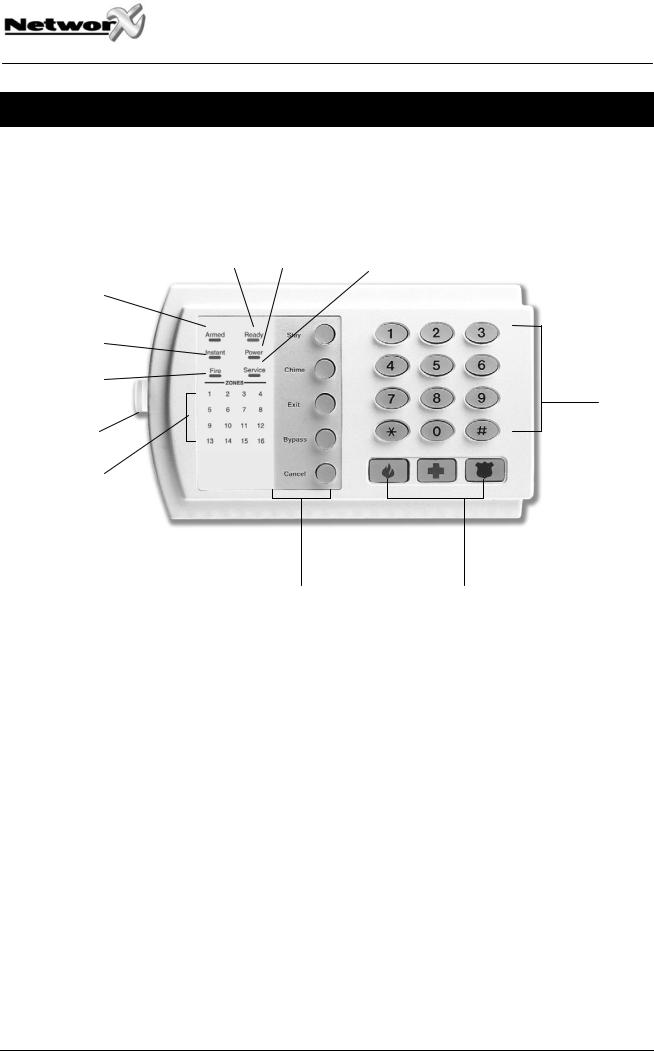GE NX-108, NX-116, NX-124E User Manual

gGE Security
NetworXTM Series
NX-108/116/124E LED keypad
User manual

gGE Security
TABLE OF CONTENTS
TABLE OF CONTENTS ................................................................................................................................................... |
2 |
INTRODUCTION .............................................................................................................................................................. |
3 |
GLOSSARY OF TERMS................................................................................................................................................... |
4 |
KEYPAD DISPLAY & LED’S......................................................................................................................................... |
5 |
UNDERSTANDING THE LIGHTS ........................................................................................................................................... |
5 |
EMERGENCY ACTIVATION KEYS ............................................................................................................................. |
7 |
KEYPAD FUNCTIONS..................................................................................................................................................... |
8 |
ARMING YOUR SYSTEM IN THE “AWAY” MODE ............................................................................................................... |
8 |
MAKING THE SYSTEM READY TO ARM ............................................................................................................................... |
8 |
ARMING YOUR SYSTEM IN THE “STAY MODE” ................................................................................................................. |
8 |
USING THE QUICK ARM (OPTIONAL).................................................................................................................................. |
9 |
CHANGING MODES WHILE SYSTEM ARMED ........................................................................................................................ |
9 |
DISARMING THE SYSTEM ................................................................................................................................................... |
9 |
CANCEL / ABORT FEATURE (OPTIONAL) ..................................................................................................................... |
10 |
BYPASSING ZONES ........................................................................................................................................................... |
10 |
GROUP BYPASS ................................................................................................................................................................ |
10 |
UNBYPASSING ................................................................................................................................................................. |
10 |
TURNING THE DOOR CHIME ON AND OFF ....................................................................................................................... |
10 |
ADDING AND CHANGING USER CODES................................................................................................................. |
11 |
ASSIGNING USER CODE AUTHORITY LEVELS.................................................................................................... |
12 |
OTHER KEYPAD FUNCTIONS.................................................................................................................................... |
13 |
SETTING THE KEYPAD TONE............................................................................................................................................. |
13 |
CHANGE PARTITION (OPTIONAL)...................................................................................................................................... |
13 |
VIEW ALARM MEMORY .................................................................................................................................................... |
13 |
TEST FUNCTION (OPTIONAL)............................................................................................................................................ |
13 |
DETECTOR RESET FUNCTION............................................................................................................................................ |
14 |
SETTING THE SYSTEM CLOCK........................................................................................................................................... |
14 |
SETTING THE SYSTEM DATE ............................................................................................................................................. |
15 |
KEYPAD CONTROL TONES (BEEPS)........................................................................................................................ |
15 |
APPENDIX A – REFERENCE TABLES....................................................................................................................... |
16 |
NX-108/116/124E User manual |
Page 2 |
04/10/04 |

gGE Security
INTRODUCTION
This manual is furnished to help you understand your security system and become proficient in its operation. All users of your security system should read and follow the instructions in this booklet and, if possible, practice on the keypad control while your professional installer is on site. Failure to do so could result in the security system not working properly. Please keep this booklet in an accessible location for the life of the security system. If you do not understand any part of this manual you should notify your installing company.
The SECURITY CONTROL PANEL can be turned on (ARMED) and off (DISARMED) by entering a 4 or 6 digit code into the keypad control, which is similar to a telephone keypad. If your security control panel has been so programmed, you may be able to turn on (ARM) your system by simply pressing the [STAY] or [EXIT] key. The system must always be disarmed using a 4 or 6 digit code.
The LED keypad includes up to 35 lights and a built-in electronic sounder. These provide specific information relating to the status of the security system which is described in the booklet. Understanding what the lights and sounds mean will help you to easily operate your system.
Keep in mind, the level of security you will obtain with this system relates specifically with two major factors:
1.The quantity, quality and placement of security devices attached to this system.
2.The knowledge you have of the security system and how that knowledge is utilized in a weekly test of the complete system.
You should be aware of the following facts when preparing a safety/security plan for your home/business:
1.Your security system is an electronic device and is subject to failure or malfunction. Do not rely on it as your single source of security.
2.Your system should be tested weekly.
3.Your system will not work without power.
4.Warning devices will need to be loud enough, wired correctly, and properly placed to provide notification of an alarm event.
5.Smoke and heat detectors may not detect heat and smoke in all situations.
6.Use qualified security professionals to install and maintain your security system.
7.It may be possible to arm the security system without the backup battery connected. Your periodic test should be done with AC Power removed to verify the battery is connected and adequately charged.
8.Care should be taken to plug in and restrain the AC transformer after testing.
Please read the following information and instructions carefully before operating your security control system.
NX-108/116/124E User manual |
Page 3 |
04/10/04 |

|
|
gGE Security |
|
|
|
|
|
|
|
|
|
|
|
GLOSSARY OF TERMS |
|
|
Abort Delay |
An option that allows a delay in reporting to the central station. |
|
|
Authority Level |
The level of access an individual has when using an alarm panel. |
|
|
Central Station |
The location where alarm data is sent during an alarm report. |
|
|
Chime Feature |
An option that allows the keypad to sound a ding-dong whenever an entry/exit |
|
|
Codes |
door is opened. |
|
|
Can be either User Codes (relating to a person) or Function Codes (a toggle |
|
|
|
|
switch to turn specific functions on/off). NOTE: A system may have either four- |
|
|
Duress Code |
digit codes or six-digit codes, but not a mixture of the two. |
|
|
An option that allows a special code to be sent to the central station that |
|
|
|
Forced Arming |
indicates the alarm system is being operated under duress. |
|
|
An option that allows the system to be turned on (ARMED) with one or more |
|
|
|
|
zones open. A system that is ready to be “force armed” will flash the ready |
|
|
Function Code |
icon. (Note: Those zones that are not ready will not create an alarm.) |
|
|
A Function Code is either a four (4) or six (6) digit code that has been |
|
|
|
Group Bypass |
programmed by the installer to operate a device. |
|
|
An option that allows the user to bypass multiple zones with a single operation. |
|
|
|
Instant/Delay |
An option that allows an instant alarm condition for Entry/Exit doors, or grants a |
|
|
|
delay to allow someone to enter/exit the building without an alarm, or before |
|
|
Master Code |
entering a user code to disarm. |
|
|
A master arm/disarm code that can program other user codes. |
|
|
|
Partitioned System |
A system divided into multiple areas in which its own user or users control each |
|
|
Perimeter |
area. |
|
|
The outer edge of the protected area. |
|
|
|
Quick Arm |
An option that allows you to turn on (ARM) the security system by pressing |
|
|
|
either the [STAY] or [EXIT] key on the keypad control (for ARMING only) as |
|
|
User Code |
programmed by the installing company. |
|
|
A four (4) or six (6) digit entry code used to arm or disarm the system. |
|
NX-108/116/124E User manual |
Page 4 |
04/10/04 |

gGE Security
KEYPAD DISPLAY & LED’S
Understanding the lights
Ready Light Power Light Service Light
Armed
Light
Instant Light
Fire Light
Numeric code entry keys
Pull out zone ID Tab
Zone Lights
5 function keys |
3 emergency activation keys |
Armed Light The armed light is “on” when the system is armed. The armed light is “off” when it is disarmed. The armed light will flash when there has been an alarm during the previous arm cycle.
Bypass Light The bypass light is “on” when any zone in this keypad’s partition is bypassed. If the bypass light is “off”, no zones are bypassed.
Cancel Light The cancel light will flash during an abort delay time. Entering a code followed by the [CANCEL] key during or after an alarm report to the central station will cause the cancel light to come on. It will stay on until the central station has received the cancel report.
NOTE: The cancel feature must be enabled. (See "Cancel/Abort Feature")
Chime Light The chime light is “on” when the chime feature is “on”; “off” otherwise.
Exit Light The exit light is “on” during the exit delay. Please note that the light will flash during the last 10 seconds of the exit delay as a warning that the time is running out. (The user may want to disarm the system if the exit light is flashing in order to prevent an alarm. The user may then re-arm the system and exit before the delay expires.)
Fire Light A steady fire light means a fire zone has been faulted. A rapidly flashing fire light means that a fire zone is in a trouble condition.
NX-108/116/124E User manual |
Page 5 |
04/10/04 |

gGE Security
Power Light The power light is on if the primary power is on. The power light will flash if the system has a low battery condition.
Ready Light The ready light is “on” when the system is ready to arm and “flashes” if ready to force arm. The ready light is “off” when the system is not ready to arm because of a zone(s) being faulted.
Stay Light The stay light is illuminated when all interior zones are bypassed.
Service Light The service light will be “on” if the security system requires service. If the service light is “on, press the [*] key followed by the [2] key to determine the service condition. One or more zone lights will illuminate indicating what service(s) is required. Call your service provider immediately for these problems. Below is a listing of what each digit means in a service condition.
|
LIGHT |
|
|
PROBLEM |
|
|
|
1 |
|
SYSTEM FAULT - Press the [1] key. The zone light(s) that is |
|||
|
|
|
illuminated corresponds to the system fault(s) below: |
|||
|
|
|
1 |
Over Current Fault |
5 |
Expander Low Battery |
|
|
|
2 |
Siren Trouble |
6 |
Expander Box Tamper |
|
|
|
3 |
Box Tamper |
7 |
Expander Trouble |
|
|
|
4 |
Expander Power |
8 |
Ground Fault |
|
|
|
Note: Faults 1 & 2 are global in nature and will affect all |
|||
|
|
|
partitions of a multi-partition system. Press the [#] key to |
|||
|
|
|
return to the 1 of 8 service lights. |
|
||
|
2 |
|
ZONE TAMPER - Press the [2] key and the zone light(s) will |
|||
|
|
|
illuminate showing the zone(s) that are tampered. Press the [#] |
|||
|
|
|
key to return to the 1 of 8 service lights. |
|||
|
3 |
|
ZONE LOW BATTERY - Press the [3] key. The zone light(s) |
|||
|
|
|
will illuminate showing which zone(s) has a low battery. This |
|||
|
|
|
only applies to wireless zones. Press the [#] key to return to the |
|||
|
|
|
1 of 8 service lights. |
|
|
|
|
4 |
|
ZONE LOSS OF SUPERVISION - Press the [4] key and the |
|||
|
|
|
zone light(s) will illuminate showing which zone(s) has loss of |
|||
|
|
|
supervision. This only applies to wireless zones. Press [#] key |
|||
|
|
|
to return to the 1 of 8 service lights. |
|
||
|
5 |
|
ZONE TROUBLE - Press the [5] key and the zone light(s) will |
|||
|
|
|
illuminate showing which zone(s) has a trouble condition. |
|||
|
|
|
Press the [#] key to return to the 1 of 8 service lights. |
|||
|
6 N |
|
TELEPHONE FAULT - Press the [6] key. The zone light(s) that |
|||
|
|
|
is illuminated corresponds to the system fault(s) below: |
|||
|
|
|
6 Line Trouble / Line Cut - This light will illuminate when |
|||
|
|
|
|
there is telephone line trouble or the telephone line has |
||
|
|
|
|
been cut. The service light will remain lit until the |
||
|
|
|
|
telephone trouble clears and a user code is entered. |
||
|
|
|
7 Auxiliary Comm Device Fail - Radio backup has failed. |
|||
|
7 N |
|
FAILURE TO COMMUNICATE - This light will illuminate when |
|||
|
|
|
there is a failure to communicate between your system and the |
|||
|
|
|
central station. |
|
|
|
|
8 N |
|
LOSS OF SYSTEM TIME - This light will illuminate when there |
|||
|
|
|
has been a loss of power and your system clock needs to be |
|||
|
|
|
reset. |
|
|
|
|
EXIT |
|
Press the [#] key to exit the Service Light mode. |
|||
|
|
|
|
|
|
|
NNote: This fault is global in nature and will affect all partitions of a multi-partition system.
NX-108/116/124E User manual |
Page 6 |
04/10/04 |
